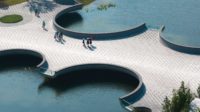The MIT Museum, dedicated to the history of invention and innovation that sprang from the university, used to be housed in a nondescript converted warehouse off campus. But now it has a prominent new home just off Kendall Square, the hub of Cambridge’s booming tech sector, at the gateway to the school.
Occupying three floors of a mixed-use tower, the 56,000-square-foot museum is something of an architectural matryoshka doll: the 17-story building was designed by Weiss/Manfredi; the museum by Höweler + Yoon; and the industrial-chic exhibition design by Wendy Evans Joseph. With so many voices, conveying a sense of what Eric Höweler calls “MIT-ness” was essential.
To that end, a principal inspiration was MIT’s so-called “infinite corridor,” a seemingly endless hall that runs more than 800 feet through the school’s original central buildings. Here, that straight line has been reinterpreted as a coiling route that spools its way up the museum’s three levels. “We kind of designed a spiral, with the galleries winding up around the building’s central core,” says Höweler.
That procession begins in a largely unadorned lobby (“rawness” also being a characteristic of MIT-ness, according to Höweler) with terrazzo floors and a mass-timber welcome desk of chunky, slightly offset horizontal planes. “When you come in, it doesn’t feel ‘tech-y,’ ” he says.
A broad, bleacher-style stair in blonde wood—the kind of auditorium seating that has become de rigueur in new academic buildings and tech offices—leads to the exhibition levels, which begin on the second floor. The stairway’s wedge-shaped rail pickets, painted dark red, provide a bit of animation, a lenticular effect that slyly references the optical art with which the museum has long been identified.

A grand stair (top of page) and lobby welcome desk (above) set the tone for the raw aesthetic throughout. Photo © John Horner, click to enlarge.
Achieving an unobstructed path up that stair required a bit of collaboration between architects. “We had opportunities to identify and support their need for open spans,” says Michael Manfredi. That meant removing a structural column and adding a steel girder to offset the 14-story load.
A second bleacher stair, this one with cut-outs giving it a “bow-tie” shape, provides a seamless route from the second floor to the third. There is also a large elevator, both for freight and those visitors who need or prefer it.
The galleries themselves similarly express the kind of flexible unpretentiousness that Höweler identifies as an essential MIT characteristic. Floors are a dark polished concrete. Above, the 17-foot ceilings are left open and painted matte black, with linear anodized-aluminum baffles carrying lighting and exhibition hardware.

1
Galleries include interactive displays (1) and a space devoted to sculptor Arthur Ganson (2). Photos © Alex Fradkin
 2
2
Joseph’s exhibition design follows the no-nonsense spirit of that envelope, in one gallery taking those metal baffles and extending them into vertical armatures for display. In the opening gallery, low metal display islands float in open space, and are characterized by white surfaces and circular metal mesh panels, a suitably mechanistic look given the technologically driven objects on view, including a folding-petal light shield for a spaceship. In a farther gallery, a selection of pieces from the museum’s collection (architectural models, a toy ship) sit in a grid of backlit plexiglass boxes, a dramatic effect, if slightly distracting to the eye.
Joseph describes the overall arrangement as a “tangram,” a geometric puzzle. “The idea is that you’re enticed into the fragmented areas, and you find your way to the things that interest you,” she says.

A study room allows students to work with objects in the collection. Photo © Alex Fradkin
Among the most distinctive of Joseph’s installations is a room devoted to 10 sculptures by Arthur Ganson, favorites in the old museum by the former resident artist at the school. Joseph has set his charming kinetic works—imagine a cross between Rube Goldberg and Marcel Duchamp—on white shelves and pedestals backed by glossy white plastic. “It is very much about seeing the shadows on a white wall, and dramatic lighting,” she says.
The museum procession concludes on the third level, at the arrival of a glassed-off room for the hands-on study of works in the collection. “We wanted people to see students working with objects,” says Höweler. What could be more MIT than that?
Click plan to enlarge

MIT Museum from Alex Fradkin on Vimeo.



Post a comment to this article
Report Abusive Comment